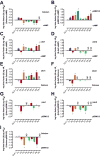Characterization of signal bias at the GLP-1 receptor induced by backbone modification of GLP-1
- PMID: 28363772
- PMCID: PMC5794489
- DOI: 10.1016/j.bcp.2017.03.018
Characterization of signal bias at the GLP-1 receptor induced by backbone modification of GLP-1
Abstract
The glucagon-like peptide-1 receptor (GLP-1R) is a class B G protein-coupled receptor that is a major therapeutic target for the treatment of type 2 diabetes. Activation of this receptor promotes insulin secretion and blood glucose regulation. The GLP-1R can initiate signaling through several intracellular pathways upon activation by GLP-1. GLP-1R ligands that preferentially stimulate subsets among the natural signaling pathways ("biased agonists") could be useful as tools for elucidating the consequences of specific pathways and might engender therapeutic agents with tailored effects. Using HEK-293 cells recombinantly expressing human GLP-1R, we have previously reported that backbone modification of GLP-1, via replacement of selected α-amino acid residues with β-amino acid residues, generates GLP-1 analogues with distinctive preferences for promoting G protein activation versus β-arrestin recruitment. Here, we have explored the influence of cell background across these two parameters and expanded our analysis to include affinity and other key signaling pathways (intracellular calcium mobilization and ERK phosphorylation) using recombinant human GLP-1R expressed in a CHO cell background, which has been used extensively to demonstrate biased agonism of GLP-1R ligands. The new data indicate that α/β-peptide analogues of GLP-1 exhibit a range of distinct bias profiles relative to GLP-1 and that broad assessment of signaling endpoints is required to reveal the spectrum of behavior of modified peptides. These results support the view that backbone modification via α→β amino acid replacement can enable rapid discovery of peptide hormone analogues that display substantial signal bias at a cognate GPCR.
Keywords: Biased agonism; Cell signaling; G protein coupled receptor; Glucagon-like peptide-1 receptor; Peptides.
Copyright © 2017 Elsevier Inc. All rights reserved.
Conflict of interest statement
The authors declare the following competing financial interest(s): S.H.G. is an inventor on a patent application covering GLP-1 analogues described here; S.H.G. is a cofounder of Longevity Biotech, Inc., which is pursuing biomedical applications of α/β-peptides.
Figures





Similar articles
-
Two distinct domains of the glucagon-like peptide-1 receptor control peptide-mediated biased agonism.J Biol Chem. 2018 Jun 15;293(24):9370-9387. doi: 10.1074/jbc.RA118.003278. Epub 2018 May 1. J Biol Chem. 2018. PMID: 29717000 Free PMC article.
-
New screening strategy and analysis for identification of allosteric modulators for glucagon-like peptide-1 receptor using GLP-1 (9-36) amide.Anal Biochem. 2015 Dec 15;491:23-30. doi: 10.1016/j.ab.2015.08.026. Epub 2015 Sep 2. Anal Biochem. 2015. PMID: 26341912
-
Evaluation of biased agonism mediated by dual agonists of the GLP-1 and glucagon receptors.Biochem Pharmacol. 2020 Oct;180:114150. doi: 10.1016/j.bcp.2020.114150. Epub 2020 Jul 17. Biochem Pharmacol. 2020. PMID: 32682761
-
The Interplay of Glucagon-Like Peptide-1 Receptor Trafficking and Signalling in Pancreatic Beta Cells.Front Endocrinol (Lausanne). 2021 May 10;12:678055. doi: 10.3389/fendo.2021.678055. eCollection 2021. Front Endocrinol (Lausanne). 2021. PMID: 34040588 Free PMC article. Review.
-
The complexity of signalling mediated by the glucagon-like peptide-1 receptor.Biochem Soc Trans. 2016 Apr 15;44(2):582-8. doi: 10.1042/BST20150244. Biochem Soc Trans. 2016. PMID: 27068973 Review.
Cited by
-
ACTH(6-9)PGP Peptide Protects SH-SY5Y Cells from H2O2, tert-Butyl Hydroperoxide, and Cyanide Cytotoxicity via Stimulation of Proliferation and Induction of Prosurvival-Related Genes.Molecules. 2021 Mar 26;26(7):1878. doi: 10.3390/molecules26071878. Molecules. 2021. PMID: 33810344 Free PMC article.
-
GLP-1 Val8: A Biased GLP-1R Agonist with Altered Binding Kinetics and Impaired Release of Pancreatic Hormones in Rats.ACS Pharmacol Transl Sci. 2021 Jan 19;4(1):296-313. doi: 10.1021/acsptsci.0c00193. eCollection 2021 Feb 12. ACS Pharmacol Transl Sci. 2021. PMID: 33615180 Free PMC article.
-
Impact of Substitution Registry on the Receptor-Activation Profiles of Backbone-Modified Glucagon-like Peptide-1 Analogues.Chembiochem. 2019 Nov 18;20(22):2834-2840. doi: 10.1002/cbic.201900300. Epub 2019 Sep 20. Chembiochem. 2019. PMID: 31172641 Free PMC article.
-
Two distinct domains of the glucagon-like peptide-1 receptor control peptide-mediated biased agonism.J Biol Chem. 2018 Jun 15;293(24):9370-9387. doi: 10.1074/jbc.RA118.003278. Epub 2018 May 1. J Biol Chem. 2018. PMID: 29717000 Free PMC article.
-
Structure and Dynamics of Adrenomedullin Receptors AM1 and AM2 Reveal Key Mechanisms in the Control of Receptor Phenotype by Receptor Activity-Modifying Proteins.ACS Pharmacol Transl Sci. 2020 Mar 20;3(2):263-284. doi: 10.1021/acsptsci.9b00080. eCollection 2020 Apr 10. ACS Pharmacol Transl Sci. 2020. PMID: 32296767 Free PMC article.
References
-
- Zaccardi F, Webb DR, Yates T, Davies MJ. Pathophysiology of type 1 and type 2 diabetes mellitus: a 90-year perspective. Postgrad Med J. 2016;92:63–69. - PubMed
-
- DeFronzo RA. Pathogensis of Type 2 (non-insulin dependent) diabetes mellitus: a balanced overview. Diabetologia. 1992;35:389–397. - PubMed
-
- Hundal RS, Inzucchi SE. Metformin: new understandings, new uses. Drugs. 2003;63:1879–1894. - PubMed
Publication types
MeSH terms
Substances
Grants and funding
LinkOut - more resources
Full Text Sources
Other Literature Sources
Miscellaneous

